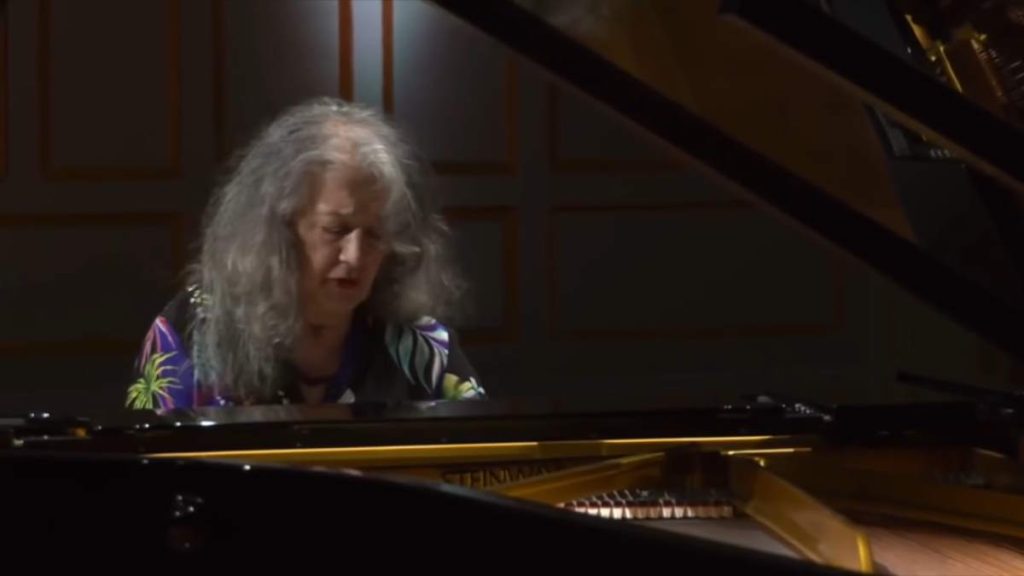Olga Scheps plays Frédéric Chopin’s Piano Sonata No. 3 in B minor, Op. 58. The piece was composed in 1844 and dedicated to Countess Emilie de Perthuis. A live recital at Mosel Musikfestival on August 30, 2015. Published by Lichtbilder Filmproduktion channel.
The sonata consists of four movements, a similar structure to the second sonata, with a lyrical largo rather than a funeral march. With the starting times in the video:
- 00:00 Allegro maestoso (in B minor, ending in B major) The work opens on a martial note, the heavy chords and filigree in the opening of the first movement giving way to a more melodic second theme, eventually leading to the conclusion of the exposition in the relative major, D. This exposition is quite long compared to other sonatas and it may be for this reason that many pianists choose to omit the exposition repeat. Motives of the original theme emerge in the development, which, unconventionally, returns to the second theme (as opposed to the first) for the recapitulation, which is in B major.
- 14:43 Scherzo: Molto vivace (in E-flat major) The scherzo, in the distant key of E-flat major and in strict ternary form, characterised by ebullient quaver runs in the right hand, with a more demure chordal middle section in B major. If played slowly, the main E-flat major theme sounds somewhat similar to the E-flat major melody from the composer’s First Ballade. Unlike the scherzo of the B-flat minor sonata (and, indeed, the rest of Chopin’s contributions to the genre outside of the sonatas), it is exceptionally short, typically lasting barely two minutes in performance.
- 18:00 Largo (in B major) Despite a stormy introduction in dotted rhythm, the largo is serene, almost nocturne-like; an immensely beautiful melody is introduced, followed by a mellow and expansive middle section, again characterized by quaver figuration in the background of an intensely harmonic line, separating the more cantabile outer sections in B major. It is the most musically profound of the movements (Kraemer, 1991), in terms of a sustained melody and innovative harmonic progression; it rivals the extensive first movement in length alone.
- 28:48 Finale: Presto non tanto (in B minor, ending in B major) Its turbulent and dramatic introduction–a rising harmonic progression left hanging on a high dominant seventh–aside, the finale, in B minor, is pervaded by a “galloping” rhythm; emphasis in the melodic line on the first and third beats of each half-measure outlines the fifth through eighth degrees of a harmonic minor scale, in this case, the F♯ and B, lending prominence to the augmented second between the sixth and raised seventh scale degrees, the G and A♯. The overall melody, chromatic yet rooted in the minor tonic, contributes a dark mood to these primary sections. A more triumphant second theme in B major, repeated twice in the movement’s A-B-A-B-A form, appears quite suddenly at the conclusion of the first (likewise when repeated); eventually rising during fleet-fingered runs over a left-hand melody, it tumbles back to a dramatic restatement of the main theme in both of its appearances. The piece concludes in a jubilant B major coda.
Olga Scheps

Olga Scheps (born January 4, 1986) is a German-Russian pianist. She began playing her first melodies and pieces aged just five years and learned to play the piano in the same was as she did speaking, walking and reading. In 1992, her family moved from Moscow to Germany, Olga Scheps’s new home.
At the age of 16, she became a young student at the Cologne Academy of Music, graduating in 2013 with a distinction. Prof. Pavel Gililov and her parents – also both pianists and piano teachers – are still important advisers to this day. Olga Scheps also gained other important musical impulses from Arie Vardi, Dmitri Bashkirov, Andrei Gavrilov and Alfred Brendel. During her studies, she held a scholarship from the German foundation Musikleben.
Olga Scheps gave some of her first concerts as part of the “Jugend Musiziert” (Youngsters Make Music) prize winners’ concert. She was then invited to perform at several concert series and festivals, such as the Rheingau Music Festival, and all of these concerts were sensational successes. Soon after, she debuted at the Ruhr Piano Festival, which she also still regularly attends and performs at.
Since 2009, Olga Scheps has been exclusively signed to Sony Classical and has recently recorded her seventh album. This solo album, featuring works by Erik Satie, was released in may 2016 and reached the Nr. 1 in the official charts in Germany. For her album “Chopin”, Olga Scheps received the ECHO award, in the category “Young artist of the Year”. All the other albums have reached the top ten in the classical charts. Olga Scheps now lives in her adopted home of Cologne, traveling from there to classical music festivals and concert series in many different countries. She performs with worldwide leading orchestras and conductors.
Olga Scheps is a Steinway Artist.
Olga Scheps describes playing the piano as “To me, music is an extension of my expressivity, the amplification of my language. The score is predetermined, but I am the interpreter. It is like acting – like the work of an actress who follows a script.”
Sources
- Piano Sonata No. 3 (Chopin) on Wikipedia
- Olga Scheps on Wikipedia
- Olga Scheps official website

